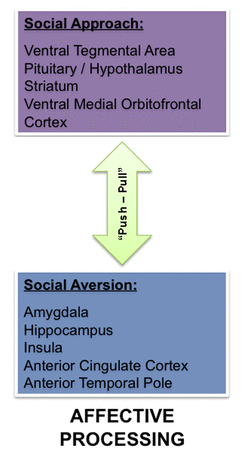I'm passing on a graphic from Vrticka's comments on recent work by Farei et al., who have observed brain activation patterns associated with sharing positive outcomes with a friends, that are also mirrored in high subjective ratings of excitement and high skin conductance responses during the same condition, reflecting increased biological arousal.

Illustration of the dynamic “push–pull” between social approach and aversion in the affective processing module of human social interaction. According to the phylogenetic perspective of social engagement and attachment proposed by Porges, human social functioning is determined by two opposite emotional brain systems representing positive (social approach; purple) versus negative (social aversion; blue) information. Whereas the social approach module mainly includes dopaminergic pathways (ventral tegmental area, striatum, ventral medial orbitofrontal cortex), as well as the pituitary/hypothalamus as the main site of oxytocin synthesis, the social aversion module operates through brain areas involved in fear/threat (amygdala), stress (hippocampus), disgust/empathy for pain/social rejection (insula and anterior cingulate cortex), and sadness (anterior temporal pole).Here is the Farei et al. abstract:
Everyday goals and experiences are often shared with others who may hold different places within our social networks. We investigated whether the experience of sharing a reward differs with respect to social network. Twenty human participants played a card guessing game for shared monetary outcomes with three partners: a computer, a confederate (out of network), and a friend (in network). Participants subjectively rated the experience of sharing a reward more positively with their friends than the other partners. Neuroimaging results support participants' subjective reports, as ventral striatal BOLD responses were more robust when sharing monetary gains with a friend as compared to the confederate or computer, suggesting a higher value for sharing with an in-network partner. Interestingly, ratings of social closeness covaried with this activity, resulting in a significant partner × closeness interaction; exploratory analysis showed that only participants reporting higher levels of closeness demonstrated partner-related differences in striatal BOLD response. These results suggest that reward valuation in social contexts is sensitive to distinctions of social network, such that sharing positive experiences with in-network others may carry higher value.

